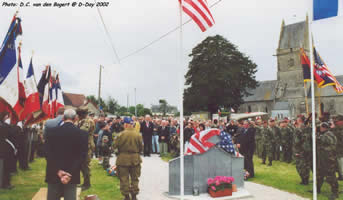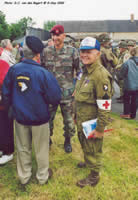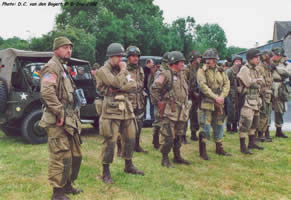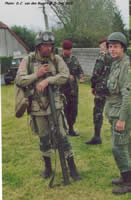Een uitzonderlijke man; Robert E. Wright. Combat Medic in 2nd Battalion 501ste Parachute Infantry Regiment van de 101ste Luchtlandingsdivisie tijdens WW2. Een man met een indrukwekkende staat van dienst.
In de D-Day nacht van 5 op 6 Juni 1944 sprong de
jonge Wright met duizenden andere US paratroopers uit een C-47 Skytrain boven
Normandië.
De meerderheid van deze troepen werd echter niet boven de voor hen bestemde
landingszône gedropt.
Verspreid over het hele schiereiland en deels zonder complete uitrusting begonnen
de Amerikaanse luchtlandingstroepen zich richting hun originele doelen te bewegen.
In de chaos die er ontstond vochten groepjes paratroopers van de twee US Airborne
Divisies en alle Parachute Infantry Regimenten door elkaar tegen de bezetter.
In eerste instantie werden er slecht weinig van de geplande opdrachten succesvol
uitgevoerd.
Het deels onder water gezette, drassige en moerasachtige terrein, doorsneden
door sloten, riviertjes en wildbegroeide bocages en kreupelhout, bleek een
nachtmerrie voor offensieve acties van beide partijen.
Nabij Angoville au Plain werd er fel gevochten waarbij er aan beide zijdes
en de burgerbevolking vele doden en gewonden vielen.
Medic Robert E. Wright en zijn collega Kenneth J. Moore vingen de gewonden
van beide strijdende partijen op in de plaatselijke kerk. Ter plekke werden
er ook burgerslachtoffers opgevangen en verzorgd. Er was één
gouden regel die door de medics gehanteerd werd: 'Geen wapens in de kerk'.
Hier werd dan ook streng op toegezien.
Terwijl de strijd buiten verder ging was de kerk van Angoville au Plain een
haven voor hen die in de strijd gewond raakten. De Medics hielpen vele tientallen
paratroopers, Duitse soldaten en burgers die ongewild in de strijd betrokken
raakten.
Op 5 juni 2002 keerde o.a. Robert E. Wright terug
naar Normandië.
Gekleed in een M42 jumpsuit met wing en medailles, en op zijn bruine jumpboots,
trad hij aan voor het onthullen van een monument schuin tegenover de kerk te
Angoville au Plain. In aanwezigheid van een Amerikaanse delegatie van de 82ste
Airborne Division, Franse lokale hoogwaardigheidbekleders en veel vlagvertoon
luisterde Wright naar de toespraken die hem ten deel vielen.
Een uur eerder had ik de eer hem in Ste Marie du Mont kort te kunnen spreken
waarbij mij opviel hoe open en nuchter deze veteraan was over de verrichtingen
van de paratroopers in Normandië.
'We just had a job, and we did the best we could
do'.
 |
 |
Een erewacht van 101st US Airborne Division Living History beoefenaars uit België, Nederland en Frankrijk, in M42 uniformen en met complete uitrusting, luisterden de ceremonie op, wat zeker op prijs werd gesteld door de veteranen.
 |
 |
An exceptional man; Robert E. Wright. Combat Medic of 2nd Battalion 501st Parachute Infantry Regiment of the 101st Airborne Division during World War 2. A man with an impressive record.
In that D-Day night in 1944 young Wright jumped out
of a C-47 Skytrain, together with thousands of other US paratroopers, invading
Normandy.
Most of these troops were not dropped above their appointed landingzones. Spread
out over the entire peninsula and almost without exception without their complete
gear, they started to move in the direction of their initial targets. In the
chaos that reigned, groups of paratroopers (consisting of men out of two Airborne
Divisions and all different Regiments) fought against the German occupant.
In the beginning only a few of the planned objectives were secured. The inundated
swamplike area, with its many streams and overgrown hedgerows turned out to
be a nightmare for offensive actions of both armies.
In the vicinity of Angoville au Plain the battle raged, with a lot of casualties
on both sides and amongst the local civilian population.
Medic Robert E. Wright and his companion Kenneth
J. Moore took care of combatants from both sides plus civilian wounded in
the local church. They had one golden rule: 'No weapons allowed in the church'.
That rule was sacred.
While the battle raged outside the church of Angoville au Plain was a safe
haven for them lucky enough to come out of this battle wounded. The medics
gave humane and lifesaving care to more then 80 paratroopers, Germans and civilians.
On June 5th 2002 Robert E. Wright returned to Normandy.
Dressed in a M42 jumpsuit with wing and medals, and wearing his brown jumpboots,
he was present during the ceremony that would reveal a monument with his
name on it. Just on the opposite side of the Angoville au Plain church. A
delegation of the 82nd Airborne Division was present, as were local French
VIP's. Wright listened to the speeches that honored him.
One hour before the ceremony I had the honor to speak briefly with this man
in Ste Marie du Mont. I was in awe at his down-to-earth honesty about the paratroopers
in Normandy.
'We just had a job, and we did the best we could
do'.
 |
 |
Re-enactors from Belgium, The Netherlands and France were also present at this ceremony, in full gear and M42 uniforms, very much appreciated by the veterans.
 |
 |